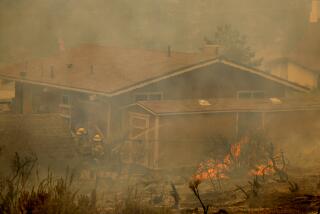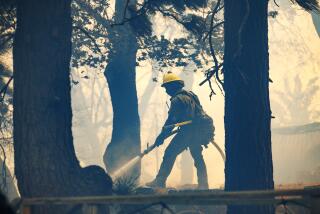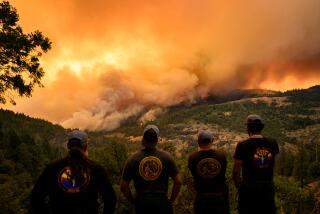The Dissension Flows Freely in Lake Arrowhead
Four years of drought have left Lake Arrowhead a community at odds, pitting neighbor against neighbor in tense disputes over their crisis and their future stability.
Community activists, residents and others around the lake are arguing over proposed building projects that could affect water supplies, strategies for evacuating the area in the event of a major fire, tree removal programs and control of the lake that provides water to 7,500 homes.
These tensions play out at local community gatherings, at homeowner meetings, in the opinion pages of regional newspapers, and on a Web site -- www.lakearrowheadcrisis.com -- started by a deputy Los Angeles city attorney and leading activist in the San Bernardino County alpine resort.
“I’m disappointed in my neighbors for squabbling among themselves,” said Bill Battison, president of the Arrowhead Communities Task Force, a coalition of 18 homeowners associations. “It’s like arguing over the best deck chair on the Titanic 20 minutes after hitting the iceberg.”
“What we have here is a convergence of disasters -- natural and man-made,” he added, “and a catharsis that can tear us apart or bring us together.”
The trouble started with dry weather, which has reduced the lake to historic lows, triggering a bark beetle infestation that has killed an estimated 100,000 trees. Amid warnings that a fire this summer could cause billions of dollars in damage and threaten lives, residents are scrambling to remove as many dead trees as possible.
Fire and law enforcement officials have devised plans to evacuate peak summer crowds of up to 80,000 people on the four highways leading out of the area. But some residents say they expect to flee in four-wheel-drive vehicles on dirt roads. Others aim to seek refuge in boats on the private lake. A few talk of driving as far as possible, then parking by the side of the road and hoofing it down the mountainsides.
The danger has placed community boosters in a difficult position. “We’re tightrope-walking,” said Lewis Murray, Lake Arrowhead’s Chamber of Commerce spokesman. “I don’t want to say anything that would cause someone to lose business. On the other hand, we want to tell the truth about the situation.”
Murray himself became the target of criticism recently for appearing in a U.S. Forest Service video called “One Way Out,” in which he suggests that the local fire danger could have a negative impact on business. The video was produced as part of an effort to persuade President Bush and Congress to approve emergency relief funds for the beleaguered area.
“I got a little heat from a few friends in the community over that,” Murray said.
‘Mass Hysteria’
Not everyone believes the threat is all that pressing. Hank Ott de Vries, general manager of the Lake Arrowhead Country Club, dismisses talk of potential catastrophes as “mass hysteria.”
“I think people are taking advantage of the drought problems to push personal political agendas,” he said. “In another 10 years, this area will be green again, and you won’t know it ever happened.”
As for the shrinking lake, he added, “If there was no lake, there’d be fewer boats and less noise. Our membership would soar.”
Others, however, argue that the Lake Arrowhead reservoir, filled in 1924, remains the grand attraction that lures more than 2 1/2 million visitors each year to the area.
At a time when the region’s 42,000 permanent residents are being asked to conserve, even the local county club and golf course -- where membership fees run about $22,000 -- is suddenly having to defend the 95% discount on lake water it has enjoyed for three decades under an agreement with the local water district.
In April, a legal battle erupted over the way the lake water is managed. The Arrowhead Lake Assn., which regulates recreation on its surface, filed a complaint with the State Water Resources Control Board alleging that the local water agency, which supplies homeowners, has exacerbated drought problems by over-drafting.
According to the complaint, the Lake Arrowhead Community Services District is harming the lake and property values by diverting more water than is replenished annually by runoff. The complaint also questions the district’s right to impound lake water.
As it stands, 15% to 20% of the boat slips and docks on the lake are unusable. If the drought continues and additional development increases demand on supplies, the lake may never recover, according to Theodore D. Heyck, deputy Los Angeles city attorney and local homeowner.
“The area cannot sustain much more development,” said Heyck, who also recently filed a separate lawsuit against the San Bernardino County Board of Supervisors for approving construction of 41 $700,000 homes without preparing an environmental impact report.
“Lake Arrowhead is going to have to grow up a little,” Heyck said. “For decades, it’s been run by a chamber of commerce and a handful of real estate interests out to promote property sales and image. That is going to change.”
‘It’s Paradise Here’
Real estate agents and developers, who are a dominant force in the local economy, hope not. Despite forecasts of disaster -- and rising home insurance rates -- Lake Arrowhead’s housing market remains brisk, local realtors said.
“So there’s lots of dead trees, the lake’s low, and there’s too many people in the market,” said Cara Jeavons, office manager at Lake Arrowhead Building Co., which constructs 10 to 12 custom homes a year ranging in cost from $500,000 to $1.3 million. “Take a look around. It’s paradise here. Smell those forest smells. People can’t wait to buy a home here and raise their kids.”
Those who already live in Lake Arrowhead and the neighboring communities of Twin Peaks, Skyforest, Rimforest and Blue Jay are growing increasing edgy about the future.
On a recent weeknight, more than 200 people -- some of them with sawdust in their hair from cutting down trees -- gathered in a banquet hall at the Lake Arrowhead Resort Hotel to hear UC Riverside fire ecology professor Richard Minnick describe the extent of the fire threat posed by what he described as a “catastrophic ecological process underway.”
“I could never have predicted this would happen,” Minnick said. “More trees died last year than during the last 300 years put together.”
Residents are paying the price for all those dead trees. As of last week, county fire authorities had issued over 2,000 notices to remove trees, mostly at homes nestled in the woods on Lake Arrowhead’s north shore. Failure to comply could result in liens placed on violators’ property.
But facing tree-cutting costs of as much as $2,000 to fell a single 100-foot-tall pine, some homeowners are hiring unlicensed workers or simply refusing to act.
On Lake Arrowhead’s devastated north shore, however, some property owners are taking extraordinary measures. Worried that state and county authorities might choose to write them off as a lost cause in a major fire, they formed “fire committees” to buy fire hoses, fireproof clothing, breathing apparatus and wrenches to open fire hydrants.
Standing on a roadside viewing area that once provided a grand vista of the lake’s 14 miles of shoreline and lush greenery, resident Robert Reed surveyed the now brown forests, sighed and said, “This used to be an alpine playground. Now it’s a scary place.”
But Battison, of the homeowners organization, predicted that “things will get better.”
“We had a simple, tranquil life until this year,” he said. “We’ll get back to that charm, but we have to pull together.”
More to Read
Sign up for Essential California
The most important California stories and recommendations in your inbox every morning.
You may occasionally receive promotional content from the Los Angeles Times.










